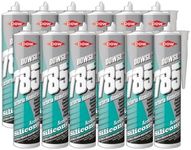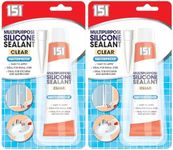Buying Guide for the Best Bathroom Sealants
Choosing the right bathroom sealant is crucial for ensuring a watertight and mold-resistant seal around your bathroom fixtures. Sealants are used to fill gaps and create a barrier to prevent water from seeping into areas where it can cause damage. When selecting a bathroom sealant, it's important to consider several key specifications to ensure you get the best product for your needs. Here are the key specs to look out for and how to choose the right one for you.Material TypeBathroom sealants are typically made from silicone, acrylic, or a hybrid of both. Silicone sealants are highly flexible, waterproof, and resistant to mold, making them ideal for areas that are frequently exposed to water, such as around bathtubs and showers. Acrylic sealants are easier to apply and clean up, but they are less flexible and not as durable in wet conditions. Hybrid sealants combine the benefits of both silicone and acrylic, offering good flexibility and ease of use. Choose silicone for high-moisture areas, acrylic for less critical areas, and hybrids for a balance of both.
Mold and Mildew ResistanceMold and mildew resistance is a crucial feature for bathroom sealants, as bathrooms are prone to damp conditions that can promote mold growth. Sealants with added fungicides or antimicrobial properties help prevent mold and mildew from forming on the sealant surface. If your bathroom is poorly ventilated or you live in a humid climate, prioritize a sealant with strong mold and mildew resistance to maintain a clean and healthy environment.
Curing TimeCuring time refers to the amount of time it takes for the sealant to fully set and become waterproof. This can range from a few hours to several days. Fast-curing sealants are convenient if you need to use the bathroom fixtures soon after application, while slower-curing sealants may offer stronger bonds and durability. Consider your schedule and how quickly you need the area to be functional when choosing a sealant with an appropriate curing time.
Flexibility and AdhesionFlexibility and adhesion are important for ensuring the sealant can accommodate movement and adhere well to different surfaces. High flexibility is essential for areas that experience temperature fluctuations or movement, such as around bathtubs and sinks. Good adhesion ensures the sealant stays in place and maintains a watertight seal. Look for sealants that are specifically designed for bathroom use, as they are formulated to provide the necessary flexibility and adhesion for these conditions.
Color OptionsBathroom sealants come in various colors, including clear, white, and other shades to match your bathroom decor. Clear sealants are versatile and blend well with any color scheme, while colored sealants can provide a more seamless look if matched to your tiles or fixtures. Choose a color that complements your bathroom's aesthetic and provides the desired finish.
Ease of ApplicationEase of application is an important consideration, especially if you plan to apply the sealant yourself. Some sealants come in easy-to-use tubes with applicator tips, while others may require a caulking gun. Look for products with smooth application properties and minimal mess. If you're a DIY enthusiast, choose a sealant that is user-friendly and comes with clear instructions to ensure a professional-looking result.
















